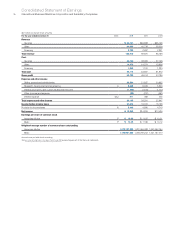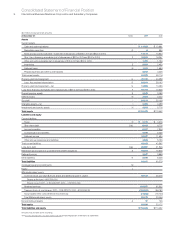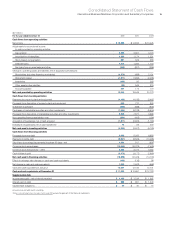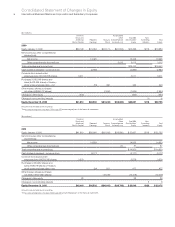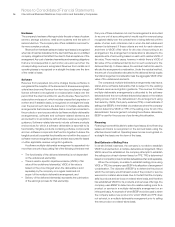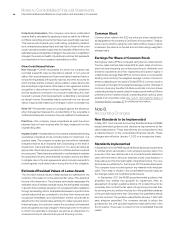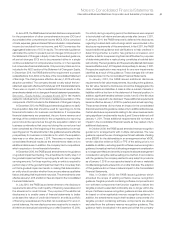IBM 2011 Annual Report Download - page 81
Download and view the complete annual report
Please find page 81 of the 2011 IBM annual report below. You can navigate through the pages in the report by either clicking on the pages listed below, or by using the keyword search tool below to find specific information within the annual report.
Notes to Consolidated Financial Statements
International Business Machines Corporation and Subsidiary Companies 79
The company determines BESP by considering multiple factors
including, but not limited to, overall market conditions, including
geographic or regional specific factors, competitive positioning,
competitor actions, internal costs, profit objectives and pricing
practices. The determination of BESP is a formal process that
includes review and approval by the company’s management. In
addition, the company regularly reviews VSOE and TPE for its
products and services, in addition to BESP.
Services Costs
Recurring operating costs for services contracts, including costs
related to bid and proposal activities, are recognized as incurred.
For fixed-price design and build contracts, the costs of external
hardware and software accounted for under the POC method are
deferred and recognized based on the labor costs incurred to date,
as a percentage of the total estimated labor costs to fulfill the
contract. Certain eligible, nonrecurring costs incurred in the initial
phases of outsourcing contracts are deferred and subsequently
amortized. These costs consist of transition and setup costs related
to the installation of systems and processes and are amortized on
a straight-line basis over the expected period of benefit, not to exceed
the term of the contract. Additionally, fixed assets associated with
outsourcing contracts are capitalized and depreciated on a straight-
line basis over the expected useful life of the asset. If an asset is
contract specific, then the depreciation period is the shorter of the
useful life of the asset or the contract term. Amounts paid to clients
in excess of the fair value of acquired assets used in outsourcing
arrangements are deferred and amortized on a straight-line basis
as a reduction of revenue over the expected period of benefit not to
exceed the term of the contract. The company performs periodic
reviews to assess the recoverability of deferred contract transition
and setup costs. This review is done by comparing the estimated
minimum remaining undiscounted cash flows of a contract to the
unamortized contract costs. If such minimum undiscounted cash flows
are not sufficient to recover the unamortized costs, a loss is recognized.
Deferred services transition and setup costs were $2,589 million
and $2,614 million at December 31, 2011 and 2010, respectively.
Amortization expense of deferred services transition and setup
costs is estimated at December 31, 2011 to be $844 million in 2012,
$652 million in 2013, $477 million in 2014, $314 million in 2015 and
$302 million thereafter.
Deferred amounts paid to clients in excess of the fair value of
acquired assets used in outsourcing arrangements were $65 million
and $78 million at December 31, 2011 and 2010, respectively.
Amortization of deferred amounts paid to clients in excess of the fair
value of acquired assets is recorded as an offset of revenue and is
estimated at December 31, 2011 to be $25 million in 2012, $18 million
in 2013, $16 million in 2014, $5 million in 2015 and $1 million thereafter.
In situations in which an outsourcing contract is terminated, the
terms of the contract may require the client to reimburse the company
for the recovery of unbilled accounts receivable, unamortized
deferred costs incurred to purchase specific assets utilized in the
delivery of services and to pay any additional costs incurred by the
company to transition the services.
Software Costs
Costs that are related to the conceptual formulation and design of
licensed software programs are expensed as incurred to research,
development and engineering expense; costs that are incurred to
produce the finished product after technological feasibility has been
established are capitalized as an intangible asset. Capitalized
amounts are amortized on a straight-line basis over periods ranging
up to three years. The company performs periodic reviews to ensure
that unamortized program costs remain recoverable from future
revenue. Costs to support or service licensed programs are charged
to software cost as incurred.
The company capitalizes certain costs that are incurred to
purchase or to create and implement internal-use software programs,
including software coding, installation, testing and certain data
conversions. These capitalized costs are amortized on a straight-
line basis over periods up to two years and are recorded in selling,
general and administrative expense. See note I, “Intangible Assets
Including Goodwill,” on pages 105 and 106.
Product Warranties
The company offers warranties for its hardware products that
generally range up to three years, with the majority being either one
or three years. Estimated costs for warranty terms standard to the
deliverable are recognized when revenue is recorded for the related
deliverable. The company estimates its warranty costs standard to
the deliverable based on historical warranty claim experience and
applies this estimate to the revenue stream for products under
warranty. Estimated future costs for warranties applicable to revenue
recognized in the current period are charged to cost of revenue.
The warranty liability is reviewed quarterly to verify that it properly
reflects the remaining obligation based on the anticipated expenditures
over the balance of the obligation period. Adjustments are made
when actual warranty claim experience differs from estimates. Costs
from fixed-price support or maintenance contracts, including extended
warranty contracts, are recognized as incurred.



